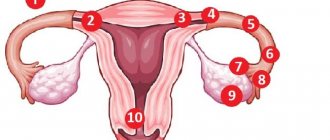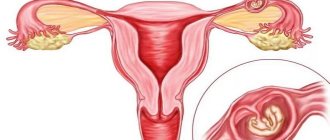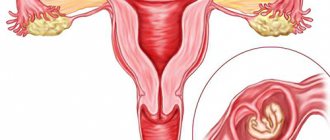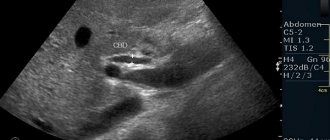Pregnancy after ectopic
Features of pregnancy planning after an ectopic pregnancy with tube removal
Pregnancy after an ectopic pregnancy (if surgery was performed and one fallopian tube was removed) most often does not occur on the first or even on the second attempt... Still, the chances of becoming a mother after such an operation drop by half, but the statistics do not apply to some women .
Much depends on the woman’s health, preparation for subsequent pregnancy, and the patency of the remaining tube. But first things first. The first thing doctors recommend to all women who have survived surgery is to protect themselves from pregnancy for about six months. Moreover, it is recommended to use birth control pills - oral contraceptives - as protection. Firstly, this guarantees almost a 100th result (pregnancy will not occur; today oral contraceptives are the most reliable means of contraception, except for the Mirena coil, but you should not use the coil). Secondly, there is evidence that after “rest” the ovaries begin to work with redoubled force - pregnancy after an ectopic pregnancy and the removal of one tube can occur sooner. And you can take modern low-dose oral contraceptives without interruptions for as long as you need, of course, if there are no contraindications to taking them.
Different birth control pills may be prescribed to different women. There is a myth that the choice depends on the individual hormonal background of the woman. However, it is not. The first choice drugs are combined oral contraceptives with a dosage of ethinyl estradiol - 20-30 mcg. These include Logest, Novinet, Janine, Lindenet 20 (and 30), Yarina, etc. You can choose depending on your financial capabilities. The price of tablets can vary quite a lot.
Source
Removal of fallopian tubes: progress of the operation, consequences for the body and rehabilitation
Quite often, young women, for one reason or another, undergo removal of one fallopian tube and, somewhat less frequently, both. The total number of such patients ranges from 3 to 12%. Among many, including doctors, there is an opinion that the fallopian tubes serve only as a “conductor” for the egg, and therefore their removal in no way can affect the general condition of the body.
At the same time, in various scientific and practical works, attention is increasingly drawn to the fact that among women with various menstrual cycle disorders and other disorders, a large number of those who have undergone such surgical treatment are identified.
Indications for salpingectomy
Salpingectomy (or tubectomy) is an operation that involves the complete removal of the fallopian tube. It can be one or two-sided and carried out on an emergency or planned basis. Salpingectomy is indicated:
In case of undisturbed tubal pregnancy, which cannot be resolved conservatively when the diameter of the ovum is more than 30 mm. Conservative methods are used if a woman wants to maintain the possibility of natural conception and pregnancy in the future. They involve pushing the fertilized egg into the ampullary part or applying a salpingostomy (communication with the abdominal cavity).
In cases of long-term salpingitis and/or salpingoophoritis (adnexitis) that is not amenable to conservative treatment, leading to significant changes in the tube, as a result of which it becomes functionally unpromising.
In the presence of one- or two-sided hydrosalpinx (accumulation of a significant amount of fluid). Infertility is often a consequence of this disease. Liquid accumulates in pipes, as a rule, due to chronic, periodically aggravated
Source
What difficulties might you encounter?
Is it so easy to get pregnant after an ectopic? Sometimes VMB acts as a factor in secondary infertility. If implantation of the fertilized egg occurs in the tube, then if it ruptures, the chances of conception may be lower. Although, even with one tube you can easily conceive a child. If it is possible to preserve the fallopian tube, then the chances of secondary ectopic attachment of the fetus in it reach as much as 95%.
Therefore, in the vast majority of cases, due to the high risk of relapse, doctors still recommend removing the fallopian tube along with the incorrectly attached fetus. And if the patient follows all the doctor’s appointments and instructions, then the likelihood of a full intrauterine pregnancy occurring is as high as possible.
How to remove an ectopic pregnancy using surgery
A condition in which a fertilized egg does not enter the uterine cavity, but is implanted in the cervix, ovary or tube, is a very dangerous phenomenon that requires immediate help.
If an ectopic pregnancy occurs, what should you do first? Immediately consult a doctor who, after examination, will prescribe treatment. In most cases this is surgery.
The growth and development of the egg occurs both in the uterine cavity and elsewhere. Only in the latter case, the tube or ovary ruptures at about eight weeks, which can result in massive bleeding and the death of the woman.
Causes and symptoms
An ectopic pregnancy develops as a result of a number of factors. The reasons for the development of this condition are obstruction of the tubes, disruption of their contraction, or the inability of the egg to penetrate into the uterine cavity due to a contraceptive - an intrauterine device.
What happens when an egg is implanted in the wrong place? An ectopic pregnancy causes severe pain and bleeding on one side. When an ovary or tube ruptures, the pain becomes unbearable and shock develops. The woman feels dizzy, the skin turns pale, and the heart rate increases. Fainting may occur, and blood pressure drops sharply.
In this case, it is not recommended to apply heat or use analgesics. You just need to call an ambulance and wait for the doctor to arrive.
Types of surgery
Surgery for ectopic pregnancy is performed as an emergency. The method of its implementation is determined by a specialist and depends on many factors (general condition, degree of blood loss, localization and presence of adhesions in the pelvis).
To perform laparoscopy
Source
Laparoscopy
Surgery to remove an ectopic pregnancy is sometimes performed using laparoscopy. It involves the use of an image enlarged in size, as well as small tools.
This method is the least traumatic. It allows you to maintain the integrity of the pipe. It is simply carefully cut open and the fertilized egg is removed.
After laparoscopy, it is necessary to cauterize the areas of all bleeding vessels. And the functionality of the fallopian tube will be preserved. It should be noted that sometimes even the use of this gentle intervention cannot protect the fallopian tube. This happens if a woman experiences repeated symptoms of pregnancy pathology.
What is the duration of surgery for ectopic pregnancy? The time will depend on the complexity of the intervention. The minimum operation time is 15 to 20 minutes. But if the situation is more serious, it may take 30 minutes to an hour.
Consequences of ectopic pregnancy
Unfortunately, sometimes the news of pregnancy can be very bad news for a woman, even if she has long and passionately dreamed of having a baby. There is absolutely nothing good about a pregnancy developing ectopically, because it is doomed to be terminated. The uterus is the only organ in a woman’s body adapted to the development and growth of the fetus inside the womb. And if for some reason the fertilized egg is not able to reach the uterine cavity and is forced to attach to it along the way, it will not be destined to develop further. Such a pregnancy must be terminated, and the sooner the better. If during a frozen pregnancy doctors sometimes take a wait-and-see approach, expecting a spontaneous miscarriage, then during an ectopic pregnancy any delay is fraught with tragic consequences, which may even include the death of the woman. The most common consequences of an ectopic pregnancy are:
An unsuccessful attempt to conceive a baby and subsequent surgery comes as a great shock. But the most important thing in such a situation is what consequences an ectopic pregnancy can have and whether it will still be possible to get pregnant, carry and give birth to a child after such an unsuccessful attempt...
The answers to these questions are not always the same. A certain percentage of women experience infertility after an ectopic pregnancy. But many of them become happy mothers even after the second and third such unsuccessful attempts.
The outcome of the abortion experienced and the chances of motherhood in the future largely depend on what kind of life the woman leads, how she monitors her health, whether rehabilitation was carried out after the operation and whether the potential mother is preparing for the upcoming conception as she should.
Today’s topic is unpleasant, but if you have experienced an ectopic pregnancy, but you are not ready to give up the happiness of having children
Source
Precautions during the postoperative period
Regardless of what kind of surgery is performed on a woman for an ectopic pregnancy, it is always unsafe. According to medical statistics, surgical intervention in the pelvic organs always entails many different negative consequences. We list the main ones:
- If an operation was performed to remove an ectopic pregnancy in the early stages, then no terrible consequences will occur. With proper treatment and a full rehabilitation course, a woman will be able to have children in the future.
- After surgery for an ectopic pregnancy, if a young woman’s fallopian tube has been removed, she will still be able to get pregnant, since her other one remains intact and unharmed. If an ectopic pregnancy occurs in a woman who is over 35 years old, then her ability to bear children is purely physiologically reduced, so she may remain infertile after surgery to remove the ectopic pregnancy.
- If a tubal abortion was performed, which left the tube but an incision was made in it, then there is a very high probability that at the next conception the fertilized egg will reattach itself in the fallopian tube rather than in the uterine cavity. Therefore, it is better for a woman who has undergone such an operation not to take risks and agree to the in vitro fertilization procedure.
- If the woman did not undergo surgery for an ectopic pregnancy, but was prescribed a drug such as Methotrexate, which stops the development of the fetus, as a result of which it dies, dissolves and comes out in the form of bleeding with clots from the vagina. It must be said that complications after such a procedure are less dangerous, but only if the measure was taken in a timely manner.
The most important and dangerous complication that can occur after surgery to remove an ectopic pregnancy is infertility. Therefore, after such a procedure, a woman must undergo a comprehensive examination and treatment so that an ectopic pregnancy does not recur.
If, for certain reasons, you had to deal with an ectopic pregnancy, then after surgery to remove it you will have to undergo a series of recovery measures. In general, rehabilitation lasts in this case at least 6 months. This period includes the following stages of recovery of the female body:
- The first week after surgery, the woman needs to be under medical supervision. During this period, specialists will monitor the postoperative suture and internal organs of the abdominal cavity (no adhesions should form on them).
- In addition, while the woman is in the hospital, the condition of the fallopian tube on which the operation was performed is monitored (doctors stop the inflammatory process in it).
- The first few months after surgery for an ectopic pregnancy, a woman will experience pain in the lower abdomen. This is normal if the pain is not aching or cutting. If it becomes unbearable, then you should immediately go to the hospital.
- During the first 2-3 weeks, a woman may experience bloody discharge after an ectopic pregnancy operation. This is a natural physiological process of self-purification of the female body.
- Menstruation after surgery for ectopic pregnancy occurs 30-40 days later, but this does not mean that the woman can begin trying to conceive a child again. It is imperative to take a six-month break, then undergo an examination and, after the doctor’s permission, try to get pregnant again. Therefore, sex after surgery for an ectopic pregnancy should be safe for the first six months. By the way, you can make love after surgery to remove the fertilized egg from the fallopian tube after 2 months.
- After surgery for an ectopic pregnancy, a woman should follow a diet. It is necessary to avoid fatty and fried foods. You should eat more fruits and vegetables (preferably fresh). They should be rich in vitamins and beneficial microelements.
- During the first 6 months, a woman needs to be constantly monitored by a gynecologist, undergo several ultrasound examinations of the reproductive organs and take special medications, which include proteolytic enzymes and biostimulants.
Do not self-medicate under any circumstances during the rehabilitation period. This is especially true for women who like to treat themselves with folk remedies. All this can be deadly for you. If you value your life and want to become a mother in the future, follow the recommendations of your doctor.
The greatest risk to a woman's life and health is a ruptured fallopian tube. This leads to large blood loss, shock, and unbearable acute pain. Even if the operation is successful, such conditions often leave scars, which leads to difficulty in conceiving, as well as an increased risk of recurrence of the pathology.
If an ectopic pregnancy is diagnosed late and the embryo has grown to several centimeters, the only possible option is to remove the tube. In some cases, doctors have to remove both. This leads to infertility and the inability to fertilize an egg naturally. When performing an operation, there is a risk of recurrence of the pathology during the next pregnancy. The organs may not fully recover, and adhesions occur that prevent the implantation of the zygote into the endometrium of the uterus.
But thanks to medical advances, there is another method to get pregnant and successfully bear a healthy baby. IVF is the only way to get pregnant after an ectopic pregnancy, after a tubectomy. In laboratory conditions, fertilization of the mother's egg with the sperm of the egg takes place. After receiving the amniotic egg, it is placed in the uterine cavity and the process then develops naturally.
After treatment of the pathology, the woman will have to go through a recovery period. Depending on the method of treatment used, the following general recommendations are prescribed:
- physiotherapy;
- taking complex vitamins;
- health improvement in sanatoriums and hospitals using mud therapy and water procedures;
- proper fractional nutrition.
In the period after the operation, the woman should refrain from physical activity, and under no circumstances should she lift heavy objects. The predominance of easily digestible foods in the diet will speed up the healing process. Bed rest must be accompanied by some kind of movement, otherwise adhesions may occur. The doctor will suggest gymnastic exercises to restore and strengthen the internal walls of the abdominal cavity. At first, you can do it in bed. After discharge from the hospital, you should continue to practice at home.
If the cause is an identified infection in the uterus, anti-inflammatory drugs are required. This will also allow the fallopian tube to be preserved when removed in case of tubectomy. The statistics are disappointing; very often subsequent pregnancies end in the recurrence of the pathology or spontaneous miscarriage.
It all depends on the woman, her psychological mood, and attitude towards her own health. Tests are required to detect infectious diseases - chlamydia, gonorrhea; if detected, treatment is carried out and only after recovery can planning begin.
Adhesions today are also not a final diagnosis; they are successfully removed with the help of laser correction and physiotherapy. The doctor will always tell you what to do. He will definitely refer you for an ultrasound to rule out the presence of benign tumors, fibroids, or cysts. When using a contraceptive device, it must be removed immediately.
It is also necessary to conduct a complete endocrinological examination. It is the hormonal background that can influence the processes of pregnancy, in particular, the pituitary gland is responsible for promoting the fertilized egg to the uterine cavity.
It is recommended to plan your next pregnancy no earlier than in 1-2 years. The general condition of the woman is also taken into account - the presence of chronic diseases and the reproductive system. At the time of a new conception, health indicators should be normal for both the expectant mother and the father. A woman’s emotions during fertilization of the egg and subsequent development also matter. If there is anxiety or fear, the contractile function of the tubes worsens, which means the risk of recurrence of the problem increases.
The opportunity to become pregnant and carry a healthy child after an ectopic pregnancy is quite high. You just need to undergo all recommended examinations and follow medical prescriptions. Then the dream of motherhood will certainly come true in the near future.
The nature of the consequences after surgery for ectopic pregnancy can be very different. If the fallopian tube ruptures, the consequences can be dire. Damage to arteries and veins may occur. Then bleeding occurs, painful sensations, and a state of shock appear.
If bleeding starts, do not waste time. Contact your doctor immediately. In twenty cases out of a hundred, a recurrence of ectopic pregnancy was recorded. If you do not carry out the correct course of rehabilitation, adhesions may appear. The pelvis and abdominal cavity are at risk. The development of inflammatory processes is typical if you do not pay attention to recovery after surgery.
The consequences of an ectopic pregnancy can also be infertility. Moreover, this situation is observed in a third of women, especially when one or two tubes were removed.
- Physical activity is unacceptable, you cannot get injured, shake, or get bruises.
- To prevent bleeding, do not lift heavy objects.
- In the case of a strip operation, you will need to wear a bandage so that the peritoneal wall is fixed.
- Don't forget that moderate physical activity is beneficial. To prevent adhesions from forming, you need to at least turn over on your side. Prescribing therapeutic exercises will also help to effectively restore the body and strengthen the peritoneum.
- Diet is important. While a woman is lying down, she should limit herself to light, nutritious and vitamin-rich meals. You should not eat foods that may cause bloating.
- You should not overcool; in the cold season you must wear warm underwear.
Surgery to remove an ectopic pregnancy: performance and methods, consequences, rehabilitation
Surgery for ectopic pregnancy is performed quite often due to the sufficient prevalence of the pathology. It can be planned or emergency, performed openly or laparoscopically.
During an ectopic pregnancy, the fertilized egg is not fixed in the uterus, but in other organs - the fallopian tube, ovary and even the peritoneum. This position of the fetus is not only incompatible with the normal development of pregnancy, but also poses a serious danger to the health or even the life of the patient.
Among the types of ectopic pregnancy there are tubal, ovarian, peritoneal, intraligamentary (between the leaves of the broad ligament of the uterus). More than 90% of cases of pathology occur in tubal localization, when a fertilized egg cannot leave the tube for implantation into the endometrium, begins to grow and is fixed to its wall by chorionic villi.
If the most comfortable conditions for the embryo have already been created in the endometrium at the time of implantation, then by definition this cannot be in the fallopian tube - the organ plays a “transit” function, delivering the egg in the direction of the uterus.
The absence of a “cushion” in the form of the endometrium and the limited space of the tube lumen create a high risk of dangerous complications. The point is not only that the growth and development of the fetus is impossible outside the uterus, although occasional cases of peritoneal pregnancy have been described. The main danger of ectopic pregnancy in the tube is the possibility of organ rupture and massive bleeding, which can cost life.
Considering the futility of preserving the fertilized egg, the impossibility of its movement into the uterus after implantation outside the endometrium and the high risk of bleeding, surgery becomes the only option for treating the pathology.
tests at the first appointment for pregnancy When registering for pregnancy, a woman is carefully monitored, during which the course of pregnancy, the risk of possible complications and the likelihood of their occurrence, the growth and development of the fetus are assessed, and, without
Ectopic pregnancy
Source
Return to a full life
After recovery, the woman will want to live a normal life again. But there are recommendations to avoid deteriorating your health:
- Before you plan to conceive, you definitely need to be examined again.
- Conception is possible only 6-12 months after surgery for ectopic pregnancy, unless there are contraindications. This period is necessary for complete recovery so that the situation does not happen again.
- You can have sexual activity no earlier than after three weeks if laparoscopy was performed. Abdominal surgery requires abstinence for at least a month.
- Sexual activity is permitted provided that contraceptives are taken.
- When a woman has her tubes removed and there is no chance of conceiving, in vitro fertilization (IVF) is recommended. To do this, at least 12 months must pass for the seams to heal well.
Ectopic pregnancy
Doctors diagnose an ectopic pregnancy when the embryo attaches for subsequent development and growth outside the uterine cavity and the pregnancy itself occurs outside the uterus. After fertilization, the egg turns into an embryo, which grows and moves through the tube to the uterus itself within 4 days. And in favorable conditions, the embryo reaches the uterine cavity itself on the 5th day. If the functioning of the fallopian tube is disrupted, the patency of the tube decreases and UMP occurs. For a long time, this diagnosis sounded like a death sentence for expectant mothers, and the only treatment was removal of the fallopian tube, and if a second pregnancy occurred outside the uterus, then the remaining tube was completely removed and spontaneous conception in the woman would not occur in the future. As a percentage, pregnancy outside the uterus occurs in 2% of all pregnant women and is one of the causes of mortality in the first trimester of an interesting situation
Types of ectopic pregnancy
- pregnancy of rare localizations (it happens that several fertilized eggs are attached outside the uterus in both tubes - this is a multiple IMP, or part is attached in the uterus - this is a combined IMP. With a combined IMP, an operation is performed and the pregnant tube is removed, but the intrauterine pregnancy is preserved and the woman successfully carries to term child)
Ectopic pregnancy causes
how to terminate an early pregnancy at home Pregnancy is a happy time in the life of every woman, but it is not always desired and turns out strictly according to plan. Sometimes you have to take desperate and decisive steps and have an abortion. And quite a few women
The main reason for pregnancy outside the uterus is the woman’s age, having crossed the 35-year mark. The next reason is disruption of the fallopian tube and a decrease in its patency due to inflammation or a past disease, as a result of which the embryo cannot be implanted into the wall of the tube due to the narrowing of the lumen. The cause is diseases such as adnexitis, chlamydia, gonorrhea, endometriosis, chronic salpingitis, tuberculosis, endocrine diseases
Source
Who's at risk
The etiology of egg implantation outside the uterus is not fully understood. Therefore, no specialist can name the specific cause of the pathology with 100% certainty.
Risk factors contributing to the development of ectopic pregnancy have been identified:
| Name | Description, influence |
| Abortion | Artificially interrupting your first conception or repeated cleanings lead to organ deformation or diseases in the genital area. |
| Inflammatory processes | They often cause tubal obstruction due to the formation of adhesions, tissue scarring, ovarian dysfunction, and lead to consequences in the form of ectopic pregnancy. |
| Infections | In 70% of cases, the pathology develops against the background of previous or concomitant viral, fungal or sexually transmitted diseases (genital tuberculosis, syphilis and others). |
| Navy | IUDs and other intrauterine contraceptives installed inside the vagina often lead to inflammatory processes in the uterus and pelvic organs, resulting in the development of an ectopic pregnancy. |
| Tumors | Benign or malignant formations in the abdominal cavity are an obstacle to normal fertilization. Lead to ectopic pregnancy. |
| Treatment | Previous operations on the reproductive organs could lead to irreversible damage. |
| Age | After 35 years, the functions of the ovaries and peristalsis decline, and the number of ovulations decreases. In girls under 18, the reproductive system is not fully formed. For example, pipes are undeveloped, too narrow or curved. |
| Diseases | When registering an ectopic pregnancy, pathologies of the endocrine and vascular systems are often observed. |
| Congenital defects | Abnormal structure of the pelvic organs. For example, infantilism (or a child's uterus), underdeveloped tortuous oviducts, narrowing of the lumen, lack of muscle contractions. |
| Psychosomatic disorders | Physical overload (especially heavy lifting), chronic stress, and emotional lability lead to ectopic pregnancy and other consequences. |
| Violation of prostaglandin production + regular use of OK | The connections are responsible for the contraction of the fallopian tubes, which ensures the normal movement of the egg. With changes, the embryo may enter an abnormal zone. Oral contraceptives based on progestogens act similarly. |
| From the man's side | Too active or, on the contrary, inactive spermatozoa, overtaking the egg in a place unusual for fertilization. |
| Stimulant drugs | According to statistics, in 10% of women, after using ovulation inducers or IVF drugs against the background of increased ovarian activation, the risk of ectopic pregnancy increases several times. |
| Bad habits | Addiction to alcohol and nicotine addiction lead to irreversible consequences. In women who smoke, the development of ectopic pregnancy is observed 5 times more often. |
Based on the factors, it is easy to come to the conclusion that in most cases the cause of the pathology is a change in the structure of tissues or a violation of the patency of the pelvic organs. It is important to diagnose the condition in time.
Lecture No. 20. Ectopic pregnancy
An ectopic pregnancy is a situation in which a fertilized egg implants and develops outside the uterine cavity. This occurs in most cases in the fallopian tubes, sometimes in the ovaries or in the abdominal cavity. Causes of ectopic pregnancy: chronic inflammation of the uterine appendages, abnormal development of the fallopian tubes, adhesions in the pelvic area caused by endometriosis, appendicitis, infectious processes after childbirth or termination of pregnancy, surgical interventions on the fallopian tubes, the use of IUDs, taking minipills and injections of medroxyprogesterone, endocrine violations.
In tubal pregnancy, the fertilized egg is implanted into the lining of the fallopian tube.
At the same time, changes occur in the uterus that are characteristic of normal pregnancy in the early stages. The cervix, isthmus, and body of the uterus increase, but to an insignificant extent. The chorion grows and becomes embedded in the wall of the fallopian tube. This is the cause of bleeding. Blood enters the cavity of the fallopian tube itself, or its wall delaminates. Changes in the endometrium of a decidual nature are less pronounced than during normal pregnancy. There are no favorable conditions in the fallopian tube for the development of the embryo, so the pregnancy is terminated. This happens between 6 and 12 weeks. Termination of pregnancy occurs by rupture of the fallopian tube or expulsion of the fertilized egg into the abdominal cavity (tubal abortion). Depending on the location of pregnancy in the fallopian tube, ampullary, isthmic, interstitial, and fibrial tubal pregnancy are distinguished. Ampullary tubal pregnancy accounts for 80% of tubal pregnancies. Since the ampullary section of the fallopian tube is its widest part, the fertilized egg can reach significant sizes. Pregnancy is most often terminated at 12 weeks. Source









